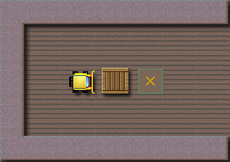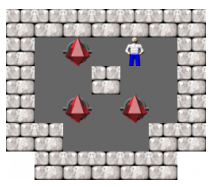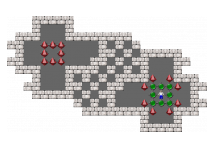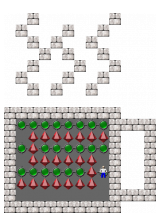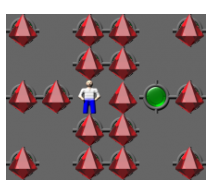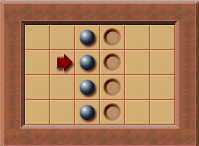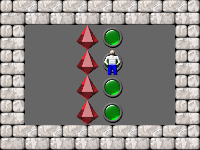Puzzle format
From Sokoban Wiki
Contents |
Puzzle
The most commonly used format for representing a Sokoban puzzle is:
| Puzzle element | Character | ASCII Code |
|---|---|---|
| Wall | # | 0x23 |
| Player | @ | 0x40 |
| Player on goal square | + | 0x2b |
| Box | $ | 0x24 |
| Box on goal square | * | 0x2a |
| Goal square | . | 0x2e |
| Floor | (Space) | 0x20 |
The simplest solvable puzzle looks like this:
##### #@$.# #####
It's important that the whole puzzle is surrounded by walls (#).
This means - assumed all boxes are removed from the board - the player musn't be able to get to the border of the puzzle. Hence a puzzle like this can't be loaded by most of the Sokoban programs:
The player can reach the right border of the puzzle, since the puzzle is not "closed".
Formats not all programs support
During the years some Sokoban programs have added support for Sokoban formats that aren't supported by many old programs.
Circular puzzles
Circular puzzles are puzzles that start in the end position.
Example puzzle:
The Sokoban implementing this puzzle type must ensure that at least one push must be made to report "solved" for such puzzles.
Note:
When implementing a solver it's important to implement a special logic for such puzzles.
Usually a solver avoids duplicate states (= all boxes at the same positions and the player has the same reachable positions).
However, in circular puzzles it is important that the initial state must be reacheable again.
Puzzles with decorative outside elements
Some puzzles have walls, boxes and goals outside the player reachable area to create a better look.
An example level is "Sasquatch 01 / Level 41":
The boxes on the left side can't be reached by the player. The whole left area is just there to for a decorative purpose.
Some programs support loading and playing these puzzles.
In case the outside elements are not all boxes on goals it's unclear what to do. Some programs refuse to load such puzzles since the number of goals and boxes does not match. However, other programs just consider and count the reachable boxes and goals and ignore the other boxes/goals.
Interior empty rows
Some puzzles look better having interior empty rows.
An example is the puzzle "Steaming Hot" by David Buchweitz.
Note: Since in the sok format an empty line is used to separate puzzle, solutions, snapshots, ... such interior empty rows can't be written as an empty line.
Hence, the rule for is: "An empty interior row is written with at least one "-" or "_".
The puzzle "Steaming Hot" can therefore be stored in a txt file like this:
# # # # # # # # # # # # # # # # # # # # - ########## #........#### # $$$$$$$# # #.$......# # # $$$$$$ # # #......$+# # #$$$$$$$ # # # #### ##########
Not closed puzzles
Some websites and programs also allow puzzles that aren't surrounded by walls. The player can move to the border of such puzzles but not further.
In extreme cases, such a puzzle doesn't have any walls at all.
An example is the puzzle "No walls" created by Rincewind:
This puzzle type is just supported by very few Sokoban implementations and not the standard! There are just a few puzzles of this type.
Solution
A solution to a puzzle is represented by the player's moves. The player can move up, down, left or right. Therefore, the letters for these directions are: u, d, l, r.
A possible solution string might look like this:
DDrdrruLruLLDllU
The uppercase letters in this solution indicate that a box is being pushed as the player moves.
Usually, this information is also stored in a solution, although the solution is still correct if all letters are lowercase.
Note: Although it's common to use the letters (n)orth, (s)outh, (e)ast and (w)est in other games, the letters u, d, l, and r have become the standard for Sokoban directions. The letters n and s are used instead for the additional directions in the Sokoban variations Hexoban and Trioban, and n, s, e and w are used for the additional directions in Octoban.
Some programs allow playing a puzzle in reverse mode.
The puzzle is displayed having all boxes at goals and the player can pull the boxes.
This way it's sometimes easier to determine the push sequence needed to solve a puzzle at the end when forward playing (-> pushing the boxes).
Reverse solutions and snapshots must start with: [] Hence, a valid reverse solution for this puzzle:
would be: []urLdrLdrLdrL
Note that in a reverse solution the pulls must be written with capital letters.
Since the player may be in different areas at the end of the puzzle the start position in reverse mode is not known when reverse mode is used.
It's therefore possible for the player to "jump" to the start position before the first pull is made.
For instance in this example puzzle:
the player starts at a goal.
Since reverse mode starts with all boxes on a goal the player would start "above" a box.
Hence, the player must "jump" to any valid start position (= a square without a wall and box).
The jump moves must be written inside the brackets. A valid reverse solution for that puzzle with initial jump moves is: [dr]RulUrddllldLuuurLdrLdrrrDluLL
Snapshot
It's also possible to save moves of the player even if they don't constitute a solution for the puzzle.
In this case these moves are called "snapshot".
The only differences between a solution and a snapshot is the fact that the moves of a snapshot don't result in a solved state of the puzzle.
Puzzle collection
Many authors publish several puzzles as a collection of puzzles.
Such a collection is named, for instance "Sokoban Perfect".
Usually all puzzles contained in this collection are then referred to as "the Sokoban Perfect puzzles".
A specific puzzle of this puzzle collection is specified by adding the number of the puzzle in that collection after the collection name.
For instance to refer to the 10th puzzle of the collection "Sokoban Perfect" one can write: "Sokoban Perfect #10" or simply "Sokoban Perfect 10".
In the case the puzzles don't have own titles they are just numbered (1, 2, 3, ...)
However, some authors also named their puzzles.
Puzzle file format
There exist various file formats for storing the data of a puzzle / puzzle collection.
The most common file extensions are: .sok, .xsb and .txt
Every file format stores the data in a different way.
Some store all data in just one file and others store different data in different files (for instance the solutions may be saved in extra files for every puzzle).
The widely used .sok-format is described here, including a detailed description of how to implement a program that can read the format.
Run length encoding
The XSB format with RLE (run-length-encoding), is more compact and efficient in mobile devices (as Palm, PocketPC, Smart Phones), besides being smaller to send for SMS. It can be used for both: puzzles and solutions.
In this format digits show how many elements of the same type are following.
#### becomes 4#
This puzzle ("Claire", by Lee J Haywood):
####### #.@ # # #$* $ # # $ # # .. # # * # #######
runlength encoded looks like this:
7#|#.@-#-#|#$*-$-#|#3-$-#|#-..--#|#--*--#|7#
The rows of the puzzle are separated by "|"s. There has been a discussion in the Yahoo Group about what character should represent an empty square in May 2006. Finally the hyphen has been elected to be the standard character for an empty square. Nevertheless, programs are encouraged to support both, hyphens and underscores.
If only two puzzle elements are grouped together they may be run length encoded, but needn't to. Example:
$$ may keep $$ or be encoded as 2$
It's recommended to write run-length encoded boards in a single line because currently some programs may not be able to handle RLE-boards spanning multiple lines. Most of the editor programs (for instance "notepad" in Windows) have a automatic wrapping of lines so there is no need for manually creating new lines. However, when a RLE board spans multiple lines, the trailing "|" on each line may be omitted.
In the RLE format empty squares at the end of a row should be omitted.
For example, this puzzle:
###__ <- two empty squares / spaces at the end of the row
#.###
#*$ #
# @ #
#####
Should be RLE this way:
3#|#.3#|#*$-#|#--@#|5#
Exchange of Sokoban puzzles in e-mails
Many e-mail servers strip empty spaces and multiple spaces, too.
To ensure the puzzles can be imported to the email recipients properly here are some suggestions:
Replace all spaces by hyphens "-" (preferred) or underscores "_".
(Recipients of your mail will have to transpose them back to spaces in order to import the puzzles into their Sokoban programs, although, some Sokoban programs will perform this transposition automatically.)
Sok format description
There is a dedicated page explaining the widely used Sok-format and its implementation in computer programs.
